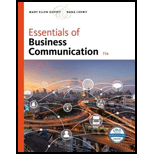
Essentials of Business Communication (MindTap Course List)
11th Edition
ISBN: 9781337386494
Author: Mary Ellen Guffey, Dana Loewy
Publisher: Cengage Learning
expand_more
expand_more
format_list_bulleted
Concept explainers
Question
Chapter 1, Problem 1.13AAC
Summary Introduction
To determine: -
The meanings of the commonly used idioms in English language.
Introduction: -
Idioms play a major role in any verbal and written communication.
Expert Solution & Answer
Trending nowThis is a popular solution!

Students have asked these similar questions
Trial Balance
Rocky Mountain Tours Co. is a travel agency. The nine transactions recorded by Rocky Mountain Tours during June 20Y2, its first month of operations, are
indicated in the following T accounts:
Cash
(1) 40,000 (2) 4,000
(7) 13,100 (3) 5,000
(4) 6,175
(6) 6,000
(9) 1,500
Equipment
(3) 15,000
Dividends
(9) 1,500
Accounts Receivable
Accounts Payable
Service Revenue
(5) 20,500 (7) 13,100
(6) 6,000 (3) 10,000
(5) 20,500
Supplies
(2) 4,000 (8) 2,200
Common Stock
Operating Expenses
(1) 40,000
(4) 6,175
(8) 2,200
Q1:
Wyatt Company had three intangible assets at the end of 2024 (end of the fiscal year):
Computer software and Web development technology purchased on January 1, 2024, for $70,000. The technology is expected to have a useful life of four years.
A patent purchased from R. Jay on January 1, 2024 for a cash cost of $6,000. Jay had registered the patent with the Canadian Intellectual Property Office seven years earlier on January 1, 2017. The cost of the patent is amortized over its legal life.
A trademark that was internally developed and registered with the Canadian government for $13,000 on November 1, 2023. Management decided that the trademark has an indefinite life.
Required:
1. What is the acquisition cost of each intangible asset?
tech 70k
patent 6k
trademark 13k
2. Compute the amortization of each intangible asset at December 31, 2024. The company does not use contra accounts. (Round the final answers to the nearest whole dollar.)
tech 17.5k
patent: ????
3-a.…
Q1:Wyatt Company had three intangible assets at the end of 2024 (end of the fiscal year):
Computer software and Web development technology purchased on January 1, 2024, for $70,000. The technology is expected to have a useful life of four years.
A patent purchased from R. Jay on January 1, 2024 for a cash cost of $6,000. Jay had registered the patent with the Canadian Intellectual Property Office seven years earlier on January 1, 2017. The cost of the patent is amortized over its legal life.
A trademark that was internally developed and registered with the Canadian government for $13,000 on November 1, 2023. Management decided that the trademark has an indefinite life.
Required:
1. What is the acquisition cost of each intangible asset?tech 70kpatent 6ktrademark 13k
2. Compute the amortization of each intangible asset at December 31, 2024. The company does not use contra accounts. (Round the final answers to the nearest whole dollar.)tech 17.5k
patent: ????
3-a. Compute the amount of…
Chapter 1 Solutions
Essentials of Business Communication (MindTap Course List)
Knowledge Booster
Learn more about
Need a deep-dive on the concept behind this application? Look no further. Learn more about this topic, subject and related others by exploring similar questions and additional content below.Similar questions
arrow_back_ios
SEE MORE QUESTIONS
arrow_forward_ios
Recommended textbooks for you
 Management, Loose-Leaf VersionManagementISBN:9781305969308Author:Richard L. DaftPublisher:South-Western College Pub
Management, Loose-Leaf VersionManagementISBN:9781305969308Author:Richard L. DaftPublisher:South-Western College Pub Understanding Management (MindTap Course List)ManagementISBN:9781305502215Author:Richard L. Daft, Dorothy MarcicPublisher:Cengage Learning
Understanding Management (MindTap Course List)ManagementISBN:9781305502215Author:Richard L. Daft, Dorothy MarcicPublisher:Cengage Learning

Management, Loose-Leaf Version
Management
ISBN:9781305969308
Author:Richard L. Daft
Publisher:South-Western College Pub

Understanding Management (MindTap Course List)
Management
ISBN:9781305502215
Author:Richard L. Daft, Dorothy Marcic
Publisher:Cengage Learning
